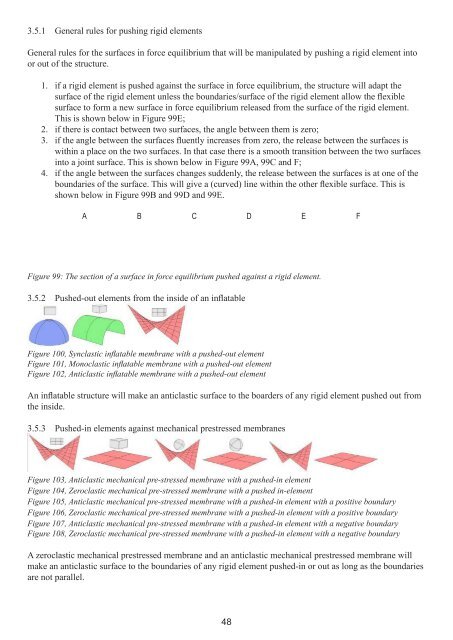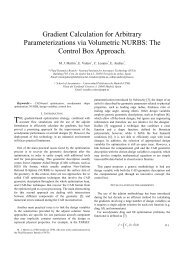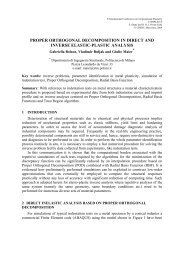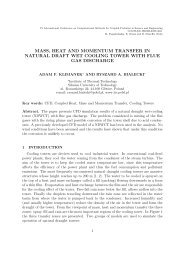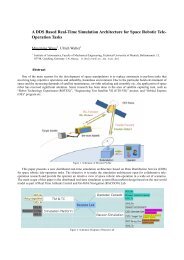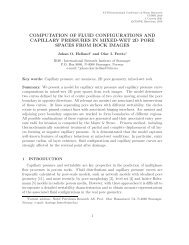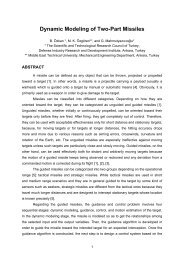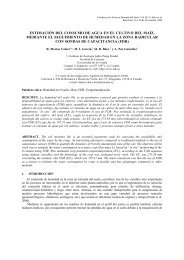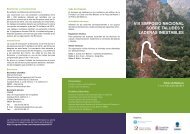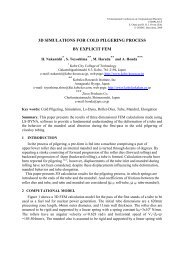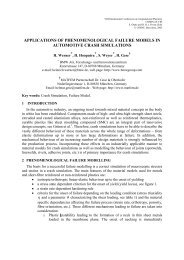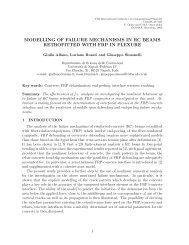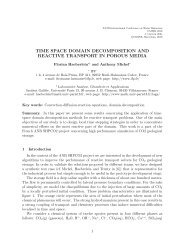- Page 1: STRUCTURAL MEMBRANES 2011V Internat
- Page 5 and 6: Textile Composites and Inflatable S
- Page 7: SUMMARYPreface ....................
- Page 11: ACKNOWLEDGEMENTSThe conference orga
- Page 14 and 15: Preliminary Investigation of Tensai
- Page 16 and 17: NUMERICAL METHODS FOR STRUCTURAL AN
- Page 19: Zoomorphism and Bio-Architecture: B
- Page 31 and 32: 1.1 Pre-stressed membranesPre-stres
- Page 33 and 34: Figure G3, G42 FORM FINDING2.1 Phys
- Page 35 and 36: of stiffness. The system oscillates
- Page 37 and 38: 3.2 Changing the pre-stress in a ce
- Page 39 and 40: oundary cables is lower and the sur
- Page 41 and 42: 3.2.6 Inflatable membranes with a c
- Page 43 and 44: 3.3.1 Force density, curvature and
- Page 45 and 46: 3.3.5 Linear load on an inflatable
- Page 47 and 48: Pushing surfaces in force equilibri
- Page 49: Figure 95, Anticlastic inflatable m
- Page 53 and 54: 7 Surface treatment:• non• surf
- Page 55 and 56: Figure 123 Concrete and the techniq
- Page 57 and 58: Space-Time FSI Modeling of Ringsail
- Page 59 and 60: Kenji Takizawa, Timothy Spielman an
- Page 61 and 62: Kenji Takizawa, Timothy Spielman an
- Page 63 and 64: Kenji Takizawa, Timothy Spielman an
- Page 65 and 66: Kenji Takizawa, Timothy Spielman an
- Page 67 and 68: Kenji Takizawa, Timothy Spielman an
- Page 69 and 70: Pressurized Membranes for Structura
- Page 71 and 72: Riccardo Barsotti and Salvatore S.
- Page 73 and 74: Riccardo Barsotti and Salvatore S.
- Page 75 and 76: Riccardo Barsotti and Salvatore S.
- Page 77 and 78: Riccardo Barsotti and Salvatore S.
- Page 79: Air Volume Elements for Distributio
- Page 82 and 83: Juergen Bellmann - Air Volume Membr
- Page 84 and 85: Juergen Bellmann - Air Volume Membr
- Page 86 and 87: Advanced Cutting Pattern Generation
- Page 88 and 89: Falko Dieringer, Roland Wüchner an
- Page 90 and 91: Falko Dieringer, Roland Wüchner an
- Page 92 and 93: Falko Dieringer, Roland Wüchner an
- Page 94 and 95: A Rotation Free Shell Triangle with
- Page 96 and 97: Fernando G. Flores and Eugenio Oña
- Page 98 and 99: Fernando G. Flores and Eugenio Oña
- Page 100 and 101:
Fernando G. Flores and Eugenio Oña
- Page 102 and 103:
Fernando G. Flores and Eugenio Oña
- Page 104 and 105:
Fernando G. Flores and Eugenio Oña
- Page 106 and 107:
Shape Analysis for Inflatable Struc
- Page 108 and 109:
Z. M. Nizam, Hiroyuki Obiya and Kat
- Page 110 and 111:
Z. M. Nizam, Hiroyuki Obiya and Kat
- Page 112 and 113:
Z. M. Nizam, Hiroyuki Obiya and Kat
- Page 114 and 115:
Z. M. Nizam, Hiroyuki Obiya and Kat
- Page 116 and 117:
Z. M. Nizam, Hiroyuki Obiya and Kat
- Page 118 and 119:
Anne Maurer, Alexander Konyukhov an
- Page 120 and 121:
Anne Maurer, Alexander Konyukhov an
- Page 122 and 123:
Anne Maurer, Alexander Konyukhov an
- Page 124 and 125:
Anne Maurer, Alexander Konyukhov an
- Page 126 and 127:
Anne Maurer, Alexander Konyukhov an
- Page 128 and 129:
Direct Area Minimization through Dy
- Page 130 and 131:
Ruy M.O. Pauletti, Daniel M. Guirar
- Page 132 and 133:
Ruy M.O. Pauletti, Daniel M. Guirar
- Page 134 and 135:
Ruy M.O. Pauletti, Daniel M. Guirar
- Page 136 and 137:
Ruy M.O. Pauletti, Daniel M. Guirar
- Page 138 and 139:
Ruy M.O. Pauletti, Daniel M. Guirar
- Page 140 and 141:
Finding Minimal and Non-Minimal Sur
- Page 142 and 143:
Ruy M. O. Paulettielement nodes at
- Page 144 and 145:
4.53.52.51.50.5-5-554.543.532.521.5
- Page 146 and 147:
Ruy M. O. Paulettiiteration (1.0015
- Page 148 and 149:
Ruy M. O. Paulettistress field is p
- Page 150 and 151:
Jan M. CremersAccurate knowledge of
- Page 152 and 153:
Jan M. CremersPrinting the transpar
- Page 154 and 155:
Jan M. CremersFigure 5: Building ph
- Page 156 and 157:
Jan M. CremersFigure 7 and 8: PV Fl
- Page 158 and 159:
Jan M. Cremers3 DESIGN PROCESSThe v
- Page 160 and 161:
Numerical Investigation of the Stru
- Page 162 and 163:
Lars De Laet, Marijke Mollaert, Jan
- Page 164 and 165:
Lars De Laet, Marijke Mollaert, Jan
- Page 166 and 167:
Lars De Laet, Marijke Mollaert, Jan
- Page 168:
Shear Deformations in Inflated Cyli
- Page 172 and 173:
Salvatore S. Ligarò, Riccardo Bars
- Page 174 and 175:
Salvatore S. Ligarò, Riccardo Bars
- Page 176 and 177:
Salvatore S. Ligarò, Riccardo Bars
- Page 179 and 180:
R. Maffei, R. Luchsinger, A. Zanell
- Page 181 and 182:
R. Maffei, R. Luchsinger, A. Zanell
- Page 183 and 184:
R. Maffei, R. Luchsinger, A. Zanell
- Page 185 and 186:
R. Maffei, R. Luchsinger, A. Zanell
- Page 187 and 188:
R. Maffei, R. Luchsinger, A. Zanell
- Page 189 and 190:
R. Maffei, R. Luchsinger, A. Zanell
- Page 191 and 192:
J. Rodriguez, G. Rio, J.M. Cadou an
- Page 193 and 194:
J. Rodriguez, G. Rio, J.M. Cadou an
- Page 195 and 196:
J. Rodriguez, G. Rio, J.M. Cadou an
- Page 197 and 198:
J. Rodriguez, G. Rio, J.M. Cadou an
- Page 199 and 200:
J. Rodriguez, G. Rio, J.M. Cadou an
- Page 201 and 202:
J. Roekens, M. Mollaert, L. De Laet
- Page 203 and 204:
J. Roekens, M. Mollaert, L. De Laet
- Page 205 and 206:
J. Roekens, M. Mollaert, L. De Laet
- Page 207 and 208:
J. Roekens, M. Mollaert, L. De Laet
- Page 209 and 210:
J. Roekens, M. Mollaert, L. De Laet
- Page 211 and 212:
J. Roekens, M. Mollaert, L. De Laet
- Page 213 and 214:
J.-C. Thomasquantify correctly the
- Page 215 and 216:
J.-C. ThomasWe finally obtain:l 0 =
- Page 217 and 218:
J.-C. ThomasRadius (m)0.260.243D re
- Page 219 and 220:
J.-C. Thomasdv/dx-theta (deg)3210-1
- Page 221 and 222:
J.-C. ThomasBending stiffness200015
- Page 223 and 224:
Recent Applications of Fabric Struc
- Page 225 and 226:
Jaime León, Carlos H. Hernández.F
- Page 227 and 228:
Jaime León, Carlos H. Hernández.O
- Page 229 and 230:
Jaime León, Carlos H. Hernández.F
- Page 231 and 232:
Jaime León, Carlos H. Hernández.F
- Page 233 and 234:
Jaime León, Carlos H. Hernández.T
- Page 235 and 236:
The Design and Application of Lante
- Page 237 and 238:
Juan G. Oliva-Salinas. Eric Valdez-
- Page 239 and 240:
Juan G. Oliva-Salinas. Eric Valdez-
- Page 241 and 242:
Juan G. Oliva-Salinas. Eric Valdez-
- Page 243 and 244:
Juan G. Oliva-Salinas. Eric Valdez-
- Page 245 and 246:
Juan G. Oliva-Salinas. Eric Valdez-
- Page 247 and 248:
Diana Peña, J. Ignasi Llorens, Ram
- Page 249 and 250:
Diana Peña, J. Ignasi Llorens, Ram
- Page 251 and 252:
Diana Peña, J. Ignasi Llorens, Ram
- Page 253 and 254:
Diana Peña, J. Ignasi Llorens, Ram
- Page 255 and 256:
Hubertus Pöppinghausheat through a
- Page 257 and 258:
Hubertus PöppinghausTextile membra
- Page 259 and 260:
Hubertus Pöppinghausemissivity coa
- Page 261 and 262:
Hubertus PöppinghausFigure 9: Meas
- Page 263 and 264:
Hubertus Pöppinghaus3. Small shadi
- Page 265 and 266:
Javier SánchezThe emergence of thi
- Page 267 and 268:
Javier SánchezFigure 4. Screenshot
- Page 269 and 270:
Javier Sánchez2.3 Dynamic interact
- Page 271 and 272:
Javier Sánchezcontrol polygon appe
- Page 273 and 274:
Experimental Manufacture of a Pneum
- Page 275 and 276:
A. Zanelli, C. Monticelli, P. Becca
- Page 277 and 278:
A. Zanelli, C. Monticelli, P. Becca
- Page 279 and 280:
A. Zanelli, C. Monticelli, P. Becca
- Page 281 and 282:
A. Zanelli, C. Monticelli, P. Becca
- Page 283 and 284:
A. Zanelli, C. Monticelli, P. Becca
- Page 285 and 286:
Lightweight PhotovoltaicsInternatio
- Page 287 and 288:
Thomas Ferwagner SOLARTENSION, Ligh
- Page 289 and 290:
Thomas Ferwagner SOLARTENSION, Ligh
- Page 291 and 292:
Thomas Ferwagner SOLARTENSION, Ligh
- Page 293 and 294:
Thomas Ferwagner SOLARTENSION, Ligh
- Page 295 and 296:
Textile Membranes for Case of Emerg
- Page 297 and 298:
Kai Heinlein and Rosemarie Wagner.3
- Page 299 and 300:
Kai Heinlein and Rosemarie Wagner.A
- Page 301 and 302:
Numerical Investigations for an Alt
- Page 303 and 304:
K. Janssen-Tapken, A. Kneer, K. Rei
- Page 305 and 306:
K. Janssen-Tapken, A. Kneer, K. Rei
- Page 307 and 308:
K. Janssen-Tapken, A. Kneer, K. Rei
- Page 309 and 310:
K. Janssen-Tapken, A. Kneer, K. Rei
- Page 311 and 312:
K. Janssen-Tapken, A. Kneer, K. Rei
- Page 313 and 314:
K. Janssen-Tapken, A. Kneer, K. Rei
- Page 315 and 316:
Michael Karwath1 INTRODUCTIONThe ta
- Page 317 and 318:
Michael Karwath3 DESIGN OF THE MULT
- Page 319 and 320:
Michael Karwath4 DESIGN OF THE STRU
- Page 321 and 322:
Development and Testing of Water-Fi
- Page 323 and 324:
B. Koppe and B. BrinkmannThe inner
- Page 325 and 326:
B. Koppe and B. BrinkmannNeverthele
- Page 327 and 328:
B. Koppe and B. Brinkmannwater tigh
- Page 329 and 330:
B. Koppe and B. BrinkmannFigure 10:
- Page 331 and 332:
B. Koppe and B. Brinkmann[2] E.S. B
- Page 333 and 334:
Klaus Reimann, Aron Kneer, Corneliu
- Page 335 and 336:
Klaus Reimann, Aron Kneer, Corneliu
- Page 337 and 338:
Klaus Reimann, Aron Kneer, Corneliu
- Page 339 and 340:
Klaus Reimann, Aron Kneer, Corneliu
- Page 341 and 342:
Klaus Reimann, Aron Kneer, Corneliu
- Page 343 and 344:
Béguin B., Breitsamter Ch. and Ada
- Page 345 and 346:
Béguin B., Breitsamter Ch. and Ada
- Page 347 and 348:
Béguin B., Breitsamter Ch. and Ada
- Page 349 and 350:
Béguin B., Breitsamter Ch. and Ada
- Page 351 and 352:
Béguin B., Breitsamter Ch. and Ada
- Page 353 and 354:
Béguin B., Breitsamter Ch. and Ada
- Page 355 and 356:
Marianna Coelho, Kai-Uwe Bletzinger
- Page 357 and 358:
Marianna Coelho, Kai-Uwe Bletzinger
- Page 359 and 360:
Marianna Coelho, Kai-Uwe Bletzinger
- Page 361 and 362:
Marianna Coelho, Kai-Uwe Bletzinger
- Page 363 and 364:
Marianna Coelho, Kai-Uwe Bletzinger
- Page 365 and 366:
Marianna Coelho, Kai-Uwe Bletzinger
- Page 367 and 368:
R. Flores, E. Ortega and E. Oñate.
- Page 369 and 370:
R. Flores, E. Ortega and E. Oñate.
- Page 371 and 372:
R. Flores, E. Ortega and E. Oñate.
- Page 373 and 374:
R. Flores, E. Ortega and E. Oñate.
- Page 375 and 376:
R. Flores, E. Ortega and E. Oñate.
- Page 377 and 378:
M. Gebhardt, A. Maurer and K. Schwe
- Page 379 and 380:
M. Gebhardt, A. Maurer and K. Schwe
- Page 381 and 382:
M. Gebhardt, A. Maurer and K. Schwe
- Page 383 and 384:
M. Gebhardt, A. Maurer and K. Schwe
- Page 385 and 386:
M. Gebhardt, A. Maurer and K. Schwe
- Page 387 and 388:
Multiscale Sequentially-Coupled FSI
- Page 389 and 390:
Kenji Takizawa, Samuel Wright, Jaso
- Page 391 and 392:
Kenji Takizawa, Samuel Wright, Jaso
- Page 393 and 394:
Kenji Takizawa, Samuel Wright, Jaso
- Page 395 and 396:
Kenji Takizawa, Samuel Wright, Jaso
- Page 397 and 398:
Kenji Takizawa, Samuel Wright, Jaso
- Page 399 and 400:
Structural Dynamic FaçadeInternati
- Page 401 and 402:
A.P.H.W. HabrakenIt is therefore mo
- Page 403 and 404:
A.P.H.W. Habraken3 DYNAMIC BEHAVIOU
- Page 405 and 406:
A.P.H.W. HabrakenFigure 7: Impressi
- Page 407 and 408:
A.P.H.W. Habraken3 PROJECT 2 - PNEU
- Page 409 and 410:
A.P.H.W. HabrakenThe pneumatic buil
- Page 411 and 412:
Concrete Shell Structures Revisited
- Page 413 and 414:
Frank Huijben, Frans van Herwijnen
- Page 415 and 416:
Frank Huijben, Frans van Herwijnen
- Page 417 and 418:
Frank Huijben, Frans van Herwijnen
- Page 419 and 420:
Frank Huijben, Frans van Herwijnen
- Page 421 and 422:
Frank Huijben, Frans van Herwijnen
- Page 423 and 424:
The Use of Fabrics as Formwork for
- Page 425 and 426:
R.PedreschiAn important aspect of t
- Page 427 and 428:
R.PedreschiIn collaboration with a
- Page 429 and 430:
R.Pedreschimomnent in a uniformly l
- Page 431 and 432:
R.PedreschiFigure 11 Concrete shell
- Page 433 and 434:
R.Pedreschiacknowledged to name the
- Page 435 and 436:
International Conference on Textile
- Page 437 and 438:
International Conference on Textile
- Page 439 and 440:
International Conference on Textile
- Page 441 and 442:
International Conference on Textile
- Page 443 and 444:
International Conference on Textile
- Page 445 and 446:
International Conference on Textile
- Page 447 and 448:
Robert P. Schmitz, P.E.concrete mem
- Page 449 and 450:
Robert P. Schmitz, P.E.the structur
- Page 451 and 452:
Robert P. Schmitz, P.E.2.3 Step 1 -
- Page 453 and 454:
Robert P. Schmitz, P.E.actually bei
- Page 455 and 456:
Robert P. Schmitz, P.E.ADINA: AUI v
- Page 457 and 458:
Robert P. Schmitz, P.E.in saving FE
- Page 459 and 460:
Alberto Gómez-González, Javier Ne
- Page 461 and 462:
Alberto Gómez-González, Javier Ne
- Page 463 and 464:
Alberto Gómez-González, Javier Ne
- Page 465 and 466:
Alberto Gómez-González, Javier Ne
- Page 467 and 468:
Krisztián HinczFigure 1: Side view
- Page 469 and 470:
Krisztián HinczFigure 4: Floor pla
- Page 471 and 472:
Krisztián HinczFigure 8: Floor pla
- Page 473 and 474:
Krisztián Hincz6000Maximum normal
- Page 475 and 476:
Krisztián Hinczconsist of two effe
- Page 477 and 478:
Krisztián HinczMaximum stress in t
- Page 479 and 480:
Thomas Kuhn, Harald Langer, Sebasti
- Page 481 and 482:
Thomas Kuhn, Harald Langer, Sebasti
- Page 483 and 484:
Thomas Kuhn, Harald Langer, Sebasti
- Page 485 and 486:
Thomas Kuhn, Harald Langer, Sebasti
- Page 487 and 488:
Marijke Mollaert, Lars De Laet, Jan
- Page 489 and 490:
Marijke Mollaert, Lars De Laet, Jan
- Page 491 and 492:
Marijke Mollaert, Lars De Laet, Jan
- Page 493 and 494:
Marijke Mollaert, Lars De Laet, Jan
- Page 495 and 496:
Marijke Mollaert, Lars De Laet, Jan
- Page 497 and 498:
Lightweight and Transparent CoversI
- Page 499 and 500:
Izis Salvador Pinto and Ben Morris.
- Page 501 and 502:
Izis Salvador Pinto and Ben Morris.
- Page 503 and 504:
Membrane Restrained ColumnsInternat
- Page 505 and 506:
H. Alpermann, C. Gengnagelby the pr
- Page 507 and 508:
H. Alpermann, C. GengnagelLooking a
- Page 509 and 510:
H. Alpermann, C. GengnagelFigure 6:
- Page 511 and 512:
H. Alpermann, C. GengnagelRegarding
- Page 513 and 514:
SOFT.SPACES _ New Strategies for Me
- Page 515 and 516:
Günther H. Filz5 INVESTIGATIONThe
- Page 517 and 518:
Günther H. Filzmostly curved surfa
- Page 519 and 520:
Günther H. FilzFig. 21 Overview ve
- Page 521 and 522:
Günther H. Filzproportionally to a
- Page 523 and 524:
Günther H. FilzCase-Study GThe for
- Page 525 and 526:
Günther H. FilzThe definition of t
- Page 527 and 528:
Direct Minimization Approaches on S
- Page 529 and 530:
M. Miki and K. Kawaguchiwas constan
- Page 531 and 532:
M. Miki and K. Kawaguchiimmediately
- Page 533 and 534:
M. Miki and K. Kawaguchiused instea
- Page 535 and 536:
M. Miki and K. Kawaguchi1 α γβN
- Page 537 and 538:
M. Miki and K. KawaguchiFig. 10 sho
- Page 539 and 540:
Reframing Textiles into Architectur
- Page 541 and 542:
I. Vrouwe, M. Feijen, R. Houtman an
- Page 543 and 544:
I. Vrouwe, M. Feijen, R. Houtman an
- Page 545 and 546:
I. Vrouwe, M. Feijen, R. Houtman an
- Page 547 and 548:
I. Vrouwe, M. Feijen, R. Houtman an
- Page 549 and 550:
I. Vrouwe, M. Feijen, R. Houtman an
- Page 551 and 552:
Step by Step Cost Estimation Tool f
- Page 553 and 554:
Robert Wehdorn-Roithmayr, Mario Gir
- Page 555 and 556:
Robert Wehdorn-Roithmayr, Mario Gir
- Page 557 and 558:
Improvement of the System of Modula
- Page 559 and 560:
Romuald Tarczewski, Waldemar Bober2
- Page 561 and 562:
Romuald Tarczewski, Waldemar BoberF
- Page 563 and 564:
Romuald Tarczewski, Waldemar Bober3
- Page 565 and 566:
Homogenization and Modeling of Fibe
- Page 567 and 568:
S. Fillep and P. Steinmannapplicati
- Page 569 and 570:
S. Fillep and P. SteinmannThe contr
- Page 571 and 572:
S. Fillep and P. Steinmannfor heter
- Page 573 and 574:
S. Fillep and P. Steinmannstrategy,
- Page 575 and 576:
Dezsı HegyiBy taking into account
- Page 577 and 578:
Dezsı Hegyi⊗=. 0(9)For small elo
- Page 579 and 580:
Dezsı Hegyi~ ~ ⋅=⋅00 ,(19)if t
- Page 581 and 582:
Dezsı Hegyi⎡ ∂ ⎤⎢ 0∂ξ
- Page 583 and 584:
Evaluation of the Structural Behavi
- Page 585 and 586:
Carlos H. Hernández.T= 35°CTemper
- Page 587 and 588:
Carlos H. Hernández.Figure 4 : sup
- Page 589 and 590:
Carlos H. Hernández.environment. T
- Page 591 and 592:
Carlos H. Hernández.the edges with
- Page 593 and 594:
Carlos H. Hernández.CONCLUSIONS- T
- Page 595 and 596:
Katsushi Ijima, Hiroyuki Obiya and
- Page 597 and 598:
Katsushi Ijima, Hiroyuki Obiya and
- Page 599 and 600:
Katsushi Ijima, Hiroyuki Obiya and
- Page 601 and 602:
Katsushi Ijima, Hiroyuki Obiya and
- Page 603 and 604:
Katsushi Ijima, Hiroyuki Obiya and
- Page 605 and 606:
Form-finding of Extensive Tensegrit
- Page 607 and 608:
A. Matsuo, H. Obiya, K. Ijima and Z
- Page 609 and 610:
A. Matsuo, H. Obiya, K. Ijima and Z
- Page 611 and 612:
A. Matsuo, H. Obiya, K. Ijima and Z
- Page 613 and 614:
A. Matsuo, H. Obiya, K. Ijima and Z
- Page 615 and 616:
A. Matsuo, H. Obiya, K. Ijima and Z
- Page 617 and 618:
Matthias Römmelt, Anastasia August
- Page 619 and 620:
Matthias Römmelt, Anastasia August
- Page 621 and 622:
Matthias Römmelt, Anastasia August
- Page 623 and 624:
Matthias Römmelt, Anastasia August
- Page 625 and 626:
Matthias Römmelt, Anastasia August
- Page 627 and 628:
Matthias Römmelt, Anastasia August
- Page 629 and 630:
Mechanics of Local Buckling in Wrap
- Page 631 and 632:
Yasutaka Satou and Hiroshi Furuya5M
- Page 633 and 634:
Yasutaka Satou and Hiroshi Furuyaan
- Page 635 and 636:
Yasutaka Satou and Hiroshi Furuyaan
- Page 637 and 638:
Yasutaka Satou and Hiroshi FuruyaIn
- Page 639 and 640:
Cédric Galliot and Rolf H. Luchsin
- Page 641 and 642:
Cédric Galliot and Rolf H. Luchsin
- Page 643 and 644:
Cédric Galliot and Rolf H. Luchsin
- Page 645 and 646:
Cédric Galliot and Rolf H. Luchsin
- Page 647 and 648:
Cédric Galliot and Rolf H. Luchsin
- Page 649 and 650:
Cédric Galliot and Rolf H. Luchsin
- Page 651 and 652:
Jörg Uhlemann, Natalie Stranghöne
- Page 653 and 654:
Jörg Uhlemann, Natalie Stranghöne
- Page 655 and 656:
Jörg Uhlemann, Natalie Stranghöne
- Page 657 and 658:
Jörg Uhlemann, Natalie Stranghöne
- Page 659 and 660:
Jörg Uhlemann, Natalie Stranghöne
- Page 661 and 662:
Jörg Uhlemann, Natalie Stranghöne
- Page 663 and 664:
James R. Ward, John Chilton and Lan
- Page 665 and 666:
James R. Ward, John Chilton and Lan
- Page 667 and 668:
James R. Ward, John Chilton and Lan
- Page 669 and 670:
James R. Ward, John Chilton and Lan
- Page 671 and 672:
Authors IndexAuthors IndexAdams N..
- Page 674:
This volume contains the full lengt


